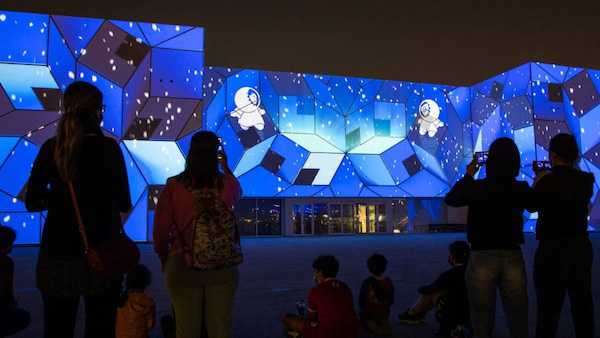Claypaky lights the Anooki show in Qatar
- Details

The Inuit-inspired Anooki characters were created by David Passegand and Moetu Batlle, founders of the French interactive design studio, Inook. The playful, parka-clad boy and girl spawned a brand and have become stars of video mapped shows worldwide. The environmental sustainability theme of the show in Qatar was particular close to the characters’ hearts: Their creators explain that since the Anooki’s house was melted by global warming they now travel the world discovering different cities.
The Anooki event spanned six days and was open to the public who pre-registered and observed COVID-19 protocols. Six-metre high inflatable Anooki characters were also installed around various Education City buildings. It is estimated that more than 7,500 people participated in the experience during its run.
For the show, the Qatar Foundation was transformed into a nighttime playground for the Anooki despite the pair’s serious environmental message. When the Anooki star in their award-winning projection mapped shows the animated characters play with the architecture of a building and react to the musical score doing things like racing across and climbing façades, peeling walls like old wallpaper, trampoline bouncing on balconies, opening windows, and crumbling stonework then reconstructing it.
“Working with lights in a projection environment is a very tricky subject because the lighting designer is always trying hard to achieve the right lighting level without effecting the projection quality on the same surface,” notes Sharif Hashisho, managing director of Qatar Vision. “For this reason, several days of programming were required by the lighting and projection teams to achieve the level of satisfaction they desired. Colours were also an important factor: Bright colours will always fight against the projected image. That’s why most of the colours used were warm and dark so they did not interfere with the projection content.”
According to Hashisho, the main purpose of the lighting installation was to create a warm wash on the building’s entire façade, as well as synchronize with the show content and music during segments with strobe effects and some iris and dimming effects.
“Claypaky has a wealth of products suitable for any kind of lighting show,” Hashisho notes. “Claypaky’s colour palette is one of the best in the market, and the quality fixtures are also very reliable when it comes to show business. Working with a reliable company and a product that will not fail you during a show is always an important factor in our selection. The K-EYE K20 wash lights we used for the Anooki project created an even, amazing wash on the façade of the building like a true paint.”
The Penrose Building’s façade is composed of two architectural layers with approximately 1.2m between the actual building wall and the front decorative cladding. Sixty Claypaky K-EYE K20 HCR fixtures were positioned between the inside wall of the building and the front, all of them hidden to the audience watching the show.
“In order to make our installation much more efficient, we rigged several trusses in between the two building layers so the lights could easily be mounted on them,” Hashisho explains. “Other lights were also installed in front of the Penrose Building to create a full wash of the decorative façade whenever needed.”
Mohammad Assaf and Mark Anton were the lighting designers for the project with Chacko Varghese technical director, Guy Bongiardino production manager, Hytham El-Sammak project manager, and Richard Di Meglio and Cyril Toussaint mapping technical directors.
















